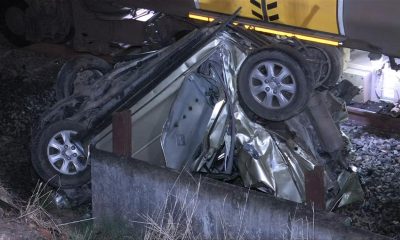Science
Sterilisation renders N95 masks unusable | E&T Magazine – E&T Magazine
University of Cincinnati researchers have demonstrated that two widely-available sterilisation methods to clean disposable surgical masks and N95 respirators make them less effective.

University of Cincinnati researchers have demonstrated that two widely-available sterilisation methods to clean disposable surgical masks and N95 respirators make them less effective.
The coronavirus pandemic has caused an explosion in demand for PPE, not just from healthcare workers but also from the general public.
According to the University of Cincinnatis Professor Sergey Grinshpun, this has led some health services to consider sterilising and reusing single-use masks. The Centers for Disease Control and Prevention has allowed reuse of N95 respirators which filter 95 per cent of airborne particles, approximately equivalent to an FFP2 mask as a crisis capacity strategy.
Grinshpun and his colleagues tested two brands of N95 respirators and two types of surgical mask (one with high filtration and one with lower filtration abilities) using two standard sterilisation techniques: autoclaving and soaking them in 70 per cent ethanol for two hours. An autoclave is a piece of apparatus which works similarly to a pressure cooker, applying steam, heat and pressure to sterilise objects.
The question for us was: what will happen with the performance of these N95 respirators and the surgical masks after they have spent minutes or longer in the autoclave and to what extent will the heat or steam destroy the structure of the filter, making the items less useful? said Grinshpun.
Grinshpun conducted tests in which the PPE was soiled with a protein, using a technique which mimicked the breathing of a healthcare worker, and then sterilised either with ethanol or in an autoclave. He repeated this cycle up to five times to simulate the reuse that may occur in a healthcare setting.
He found that while sterilisation did not cause visible damage to the surgical masks, it caused damage to the N95 respirator, including the disintegration of sealing material around the nose clip and loss of strap elasticity. The sterilisation process also weakens the electrostatic charge in fibres in surgical masks and N95 respirators, which allow the fibres to capture small particles.
In some cases, this reduced the collection efficiency of the N95 respirators to below their certification level of 95 per cent.
It almost didnt matter how often we decontaminated the protective devices once, twice or five times, since the major damage inflicted on the performance characteristics of the items followed the first test, Grinshpun said.
You are going to lose in performance if these masks or respirators are sterilised using either of these treatments. Of course, quantitatively, the effect differs for different devices.
Grinshpun said that rather than relying on autoclaving or ethanol, alternative sterilisation techniques such as the use of UV light may be explored. The researchers did not look at UV in this study as they intended to first examine the methods which are readily available in hospitals.
We anticipated that UV-based and probably other techniques may be almost as efficient as autoclaving and ethanol treatment in inactivating pathogens, but at the same time would not damage the fibres of protective devices so that the particle collection efficiency will not suffer, said Grinshpun. Similar studies can and should be conducted with alternative decontamination methods.
The question of how the disinfection treatments impact the performance and integrity of respiratory protective devices remains important for as long as healthcare workers have to reuse these devices due to their shortage of

-

 Noosa News19 hours ago
Noosa News19 hours agoPhotographer Nadia Shevtsova remembered by family in touching tribute after deadly crash at Gold Coast
-

 General10 hours ago
General10 hours agoFrom jackaroo to ‘Golden Tonsils’ radio titan: the life and career of John Laws
-

 General13 hours ago
General13 hours agoMajority of Australia’s first Ashes Test squad to feature in Sheffield Shield round four
-

 Noosa News21 hours ago
Noosa News21 hours agoWoman’s lucky escape after car rolls and crashes onto tracks before being hit by oncoming train in Kingston, Logan
